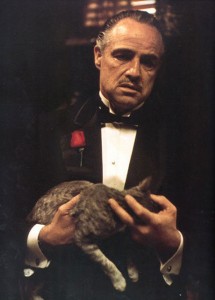Brands
If The Godfather Was a Content Marketing Guru
When creating a content strategy, it’s useful to look for inspiration from one of the original content marketing fields: film. Movies offer a host of lessons for the content marketer.
 Allan Tan of Content Marketing Institute created his own set of 4 Golden Rules for Successful Content Brainstorms inspired by The Godfather.
Allan Tan of Content Marketing Institute created his own set of 4 Golden Rules for Successful Content Brainstorms inspired by The Godfather.
Rule 1: Leave “the judge;” bring “the kid”
Choose the members of your brainstorming team carefully and keep it small so everyone will have a better chance to have their ideas heard. Select people who are less “judging” and more intuitive and perceptive. The goal is to make sure that enthusiasm doesn’t get killed and that creative thinking is encouraged.
Tan says to be prepared to have fun, and remember to think: “There are no bad ideas — merely unfinished ones.”
Rule 2: It’s not business, Sonny. It’s strictly creative
Tan says that since “creativity is messy and fun,” the environment of a brainstorm should generate excitement. Bring elements in such as cheerful magazines, pictures, soccer balls, and noisemakers. Rearrange the furniture. Bring snacks. Make sure that there are materials available to capture every idea, including Post-it notes and plenty of pencils and pens.
Rule 3: When it comes to ideas, go “to the mattresses”
According to Tan, a brainstorming session is not meant to produce the perfect idea or to “crack the brief.” Use time after the brainstorm to organize ideas, but not during the actual brainstorm. As the facilitator, keep the energy high and encourage crazy ideas.
Rule 4: If anything in this life is certain, it’s that anyone can be creative
Sometimes the great ideas won’t happen during the brainstorm, but afterward as they leap into consciousness while doing something mundane, like washing the dishes. That does not mean the brainstorm wasn’t successful, if anything it did the job.
Tan says “great brainstorming sessions can act as a catalyst for breaking up the crud that’s blocking up your creative ability.”
For more inspiration, look up the 21 Types of Content Audiences Love.
In the spirit of getting inspired by the movies and keeping content marketing fun, Renee DeCoskey offers her take on What Content Marketing Can Learn from the Movie Industry.
The Documentary
Whether documentaries are film-length productions made for television or the big screen, there is always someone who is spending a lot of time, money, and other resources doing research so that the information the viewer receives is as accurate as possible. The way DeCoskey sees it, content marketing isn’t much different.
“When you’re creating a content strategy, one of your primary objectives is probably to educate your visitors in some way,” she says.
Avoid Typecasting
It’s always good to take a chance on a role that’s different from what you usually do. Just like actors, content marketers should learn to step out of their comfort zone. Before falling into a rut, DeCoskey says to shake it up before getting too bored, “otherwise you risk burning out and fading into oblivion.”
Deep Focus
In the movie industry, deep focus refers to a cinematographic technique in which a large depth of field is used. Instead of a lot of back and forth shots or slicing and dicing in the editing room, the scene is allowed to play out.
“Think of deep focus a bit like using longer pieces as part of your content strategy,” explains DeCoskey, “Instead of a lot of slicing and dicing and trying to keep your content below 800 words, let it play out.”
While being brief is often preached when it comes to effective content strategy, sometimes there is content that requires more “length,” like a long blog post, a blog series, or an eBook.
Image courtesy of TRF_Mr_Hyde/flickr

Get better at your job right now.
Read our monthly newsletter to master content marketing. It’s made for marketers, creators, and everyone in between.




